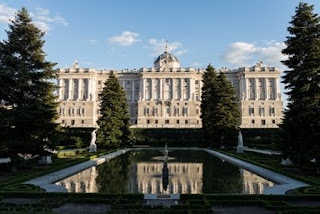“To meet or not to meet”
No hay nada que les guste más a los españoles que reunirse y hablar. De hecho en español tenemos muchos verbos que definen el acto de reunirse, que envuelven un pequeño matiz o diferencia. Y todos ellos se pueden traducir al inglés como “to meet”.Vamos a
revisar estos verbos en los diferentes contextos en los que los podemos usar.
ENCONTRARSE.
El otro
día me encontré a María (en la calle)
The other day I met Maria (on the street)
Usamos
“encontrarse” en el sentido de “bumping into someone”
REUNIRSE.
Nos
reunimos en casa de Lourdes y pasamos una tarde estupenda.
We met at Lourdes’s house and we had a lovely evening.
Usamos
reunirse en el sentido de “to get together” para referirnos a un evento que
hemos organizado.
QUEDAR
-¿A qué hora quedamos? At what time shall we meet?
*Pues,
quedamos a las 17.00, en la cafetería de la esquina.
* Let’s meet at 17.00, at the coffe shop, in the corner.
JUNTARSE
Nos
juntamos toda la familia para celebrar el cumpleaños de Sara
All the family met to celebrate Sara’s birthday.
Usamos juntarse con el mismo sentido de “to get together”.

Juliette y yo nos conocimos en la universidad. Juliette and I met at the university.
Y aquí
es donde la confusión empieza porque en español hemos cambiado de verbo y
significado “CONOCER” “to meet someone for the first time”.
Correcto:
Me reuní
con Juliette, mi amiga de la universidad el fin de semana pasado
I met Juliette, mi university friend, last weekend.
Conocí a Juliette, mi amiga de la Universidad, hace 20 años, en Madrid.
I met Juliette, my university friend, 20 years ago, in Madrid.
Conocí a Juliette, mi amiga de la Universidad, el fin de semana pasado.
I met Juliette (for the first time) ,my university friend, last weekend.
(Incorrecto! Because we met 20 years ago, but we were meeting for some drinks last weekend, We need to use REUNIRSE o QUEDAR)
“CONOCER”
también se traduce como “to KNOW” Es
correcto, pero usamos CONOCER con el sentido de “to know” cuando decimos si
sabemos quién es esa persona o no.
No la conozco. I don’t know her. (I don’t know who she is)
Hola, no nos conocemos, me llamo Tere… Hello, we don’t know each other, I’m Tere…
“To meet or not to meet”

Let’s review these verbs and the different context where we can use them.
ENCONTRARSE.
El otro
día me encontré a María (en la calle)
The other day I met Maria (on the street)
We use “encontrarse” with the meaning of “bumping into someone”
REUNIRSE.
Nos reunimos
en casa de Lourdes y pasamos una tarde estupenda.
We met at Lourdes’s house and we had a lovely evening.
We use “reunirse” with the meaning of “to get together” to refer that we have organise to meet with that friend/s or family, for a coffee or for an event.
QUEDAR
-¿A qué hora quedamos? At what time shall we meet?
*Pues,
quedamos a las 17.00, en la cafetería de la esquina.
* Let’s meet at 17.00, at the coffee shop, in the corner.
JUNTARSE
Nos
juntamos toda la familia para celebrar el cumpleaños de Sara
All the family met to celebrate Sara’s birthday.
We use “juntarse” with the same meaning of “to get together”.
There is one more context when we use “TO MEET”: when we talk about the first time we met someone:
Nos conocimos hace 20 años. We met 20 years ago.Juliette y yo nos conocios en la universidad. Juliette and I met at the university.
Recap: We can’t use CONOCER when we mean that we are meeting our friends/family, or we met them for a drink or catch up.
Correcto:
Me
reuní con Juliette, mi amiga de la universidad el fin de semana pasado
I met Juliette, mi university friend, last weekend.
Conocí
a Juliette, mi amiga de la Universidad, hace 20 años, en Madrid.
I met Juliette, my university friend, 20 years ago, in Madrid.
Incorrecto:
Conocí
a Juliette, mi amiga de la Universidad, el fin de semana pasado.
I met Juliette (for the first time) ,my university friend, last weekend.
( Incorrect! Because we met 20 years ago, but we were meeting for some drinks last weekend. We need to use REUNIRSE o QUEDAR)
Conocer is also traslated as “to KNOW” That’s correct, but we use CONOCER when we want to express if you know someone or it’s is an unknown person for us.
Hola, no nos conocemos, me llamo Tere… Hello, we don’t know each other, I’m Tere...














